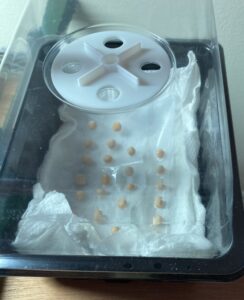
What triggers seed germination? Most seeds will start to sprout and grow when they are placed in a warm, moist environment. In this activity, students observe seed germination and learn how to calculate the germination percentage of a batch of seeds.
Below are links to several time lapse video of seed germination, so students can get an idea of what to expect when they set up their seed germination activity.
- A time lapse video of white radish seed germination in soil produced by J K-H
- Corn seed germination in soil produced by the Kansas Corn STEM project:
- A time lapse of mung bean seed germination, which took place over 3.5 days:
Why is knowing a seed germination rate important? Growers want to know seed germination rates, because this affects how many plants will grow after being planted. Germination rates play an important role in predicting crop harvest production. How can you tell if a seed will produce a plant or not? If growing a maximum number of seeds in a field is important, how might you design an experiment to test for how many seeds will grow? This activity will help you do just that.
How you can easily test germination rates. You can set up seed germination tests in several ways. The image below shows my test for 25 VNS Yellow Field Pea (Pisum sativum) seeds. I like being able to see the seeds during the germination process. Using a container with a transparent, sung-fitting lid keeps the moisture from evaporating too quickly, and the rotating dial in the top of the lid allows some air to circulate to the seeds to prevent the growth of mold on the seeds.

Download this activity. Try it with your students or at home. LEVEL 1 LESSON 1 Germination_Activity2.
Results of my home test of this activity will be available in the next blog.
Find out how to join the Growing Food with Hydroponics project by clicking the link below.

